10 Best Low-Light Aquarium Plants for Beginners – Reviews & Top Picks 2024
Updated on
Aquarium plants enhance the aesthetics of a fish tank and play a vital role within the aquarium’s ecosystem. They act as a natural filter for harmful chemicals and excess nutrients while increasing oxygen levels in the water.
Additionally, they provide shelter to the fish and prevent algae growth.
For beginners, low-light aquarium plants are perfect because they are low maintenance. They can thrive in darker environments while not requiring as many supplements or as much carbon dioxide. What’s more, most low-light plants for aquariums have a fast growth rate.
Thanks to their meager needs, these plants will not hurt your pockets. If you have just bought your aquarium, you have come to the right place.
The following are reviews of the best low-light aquarium plants for beginners.
A Quick Comparison of Our Favorites in 2024
| Rating | Image | Product | Details | |
|---|---|---|---|---|
| Best Overall |
 |
Anubias |
|
Check Price |
| Best Value |

|
Java Fern |
|
Check Price |
| Premium Choice |

|
Java Moss |
|
Check Price |

|
Cryptocoryne Species |
|
Check Price | |

|
Amazon Sword |
|
Check Price |
Top 10 Low-Light Aquarium Plants for Beginners
1. Anubias
- Growth rate: Moderate
- Max height: 8 inches
- Light demands: Low
- CO2: Low
- Difficulty: Easy
The Anubias is one of the most popular plant species for low-tech tanks, thanks to its ability to thrive without requiring much attention. It is also tolerant of a wide array of conditions and environments.
Native to West Africa, this plant comes with broad, round leaves and does best when attached to rocks or driftwood as it has not evolved to grow in substrate.
The Anubias is not tolerant of harsh light. Therefore, if your aquarium is exposed to a lot of light, consider creating shade in the tank by adding plants that float on the surface.
Owing to its broad, sturdy leaves, the plant provides an excellent surface for fish to rest on. Betta fish, especially, are fond of resting amongst the leaves of the Anubias. Unfortunately, it is rather pricey.
- Rarely nibbled on by fish thanks to its waxy texture
- Broad leaves that provide shelter
- Aesthetically pleasing
- Can grow without a substrate
- Pricey
2. Java Fern
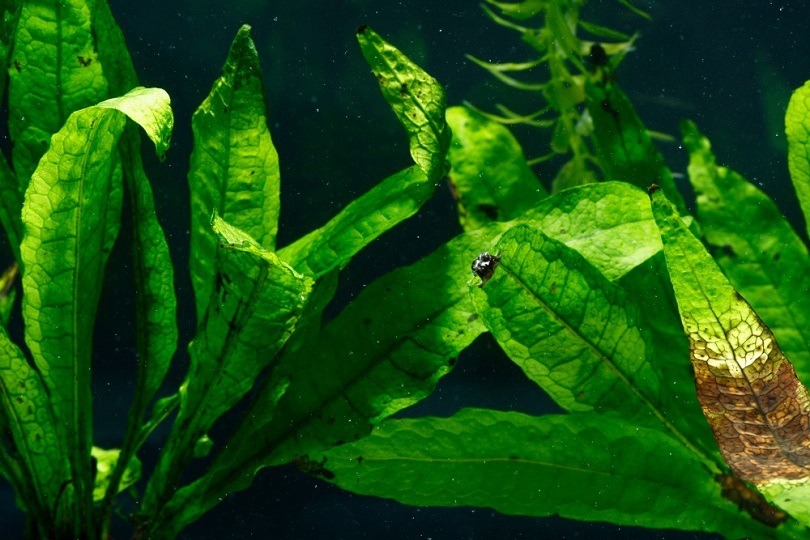
- Growth rate: Slow
- Max height: 12 inches
- Light demands: Low
- CO2: Low
- Difficulty: Easy
The Java Fern is another hardy, tolerant, and aesthetically pleasing low light aquarium plant. This plant grows into nice and dense bushes that will give your fish somewhere to hide. What’s more, it is easy to take care of, as it does not demand a lot of attention.
Getting started with the Java Fern is easy; all you need to do is attach it to rocks or driftwood, and you are set to go.
The Java Fern achieves a maximum height of 12 inches, making it a good fit for most tanks. Additionally, propagating it is easy work, as all you have to do is split up the rhizome. However, you are advised against burying the rhizome in substrate because it can result in rotting.
Unfortunately, due to its slow growth rate, this plant is susceptible to algae growth. You can solve that problem by removing the leaves with the growth.
- Attractive
- Hardy
- Easy to care for
- Susceptible to algae growth
3. Java Moss
- Growth rate: Moderate
- Max height: 4 inches
- Light demands: Low
- CO2: Low
- Difficulty: Easy
The Java Moss is an incredibly resilient aquatic moss that can withstand numerous types of conditions. Plus, it’s easy to set up. You can attach it to rocks or driftwood both above and below the water to give your aquarium a “natural” look. It is for that reason that Java Moss is popular among terrariums and paludariums.
However, to enhance this plant’s chance of attaining its best form, make sure that the tank’s lid is tight fitting so it can trap the moisture and create a humid environment.
This moss provides a cover that is great for fish that need places to hide or breed. Additionally, the biofilm on its fronds provides the fish with something to nibble on.
It should be noted that Java Moss’s extensive coverage creates a trap for debris. This could make cleaning the tank difficult.
- Resilient
- Looks nice in any tank
- Easy to set up
- Provides hiding spots
- Traps dirt and debris
4. Cryptocoryne Species
- Growth rate: Moderate
- Max height: 12 inches
- Light demands: Low
- CO2: Low
- Difficulty: Easy
Also known as “crypts,” Cryptocorynes are excellent low light plants to have in your aquarium, especially when looking to fill out the tank’s floor. They come in different species and sizes. If your aquarium is smaller, consider going with the Cryptocoryne wendtii, as it rarely exceeds 6 inches in height.
These species also come in a wide range of colors.
However, crypts can be quite finicky when getting used to a new tank, often experiencing discoloration or having some of their leaves die off during the acclimatization process. Fortunately, most do not die and should start growing normally within no time.
But it is important to familiarize yourself with the proper methods of introducing the plant to an aquarium before buying.
- Come in a wide variety of colors
- Great for covering the floor
- Consists of various species to suit different aquariums
- Can have difficulty acclimating to a new tank
5. Amazon Sword
- Growth rate: Slow
- Max height: 15 inches
- Light demands: Moderate
- CO2: Low
- Difficulty: Easy
The Amazon Sword is a good fit for those with large aquariums, as this plant averages 15 inches tall. The leaves of an Amazon Sword feature a variety of shapes and sizes, allowing you to choose one that suits you best.
These plants must be grown in substrate. Additionally, they require high amounts of nutrients to thrive. While that might intimidate a beginner, planting and feeding are quite easy.
While Amazon Swords can do well in low light aquariums, they do best when exposed to about 10 hours of medium light. The plants experience a slower rate of growth in low light conditions, which can result in algae growth if you are not careful.
- Great for large aquariums
- Wide variety of leaf types
- Can grow in various light conditions
- Slow rate of growth makes them susceptible to algae growth
6. Marimo Moss Balls
- Growth rate: Slow
- Max height: 25 inches
- Light demands: None
- CO2: Low
- Difficulty: Easy
Morimos are unique and rare algae that are characterized by small, rounded, green balls.
These ornamental pieces will add to the aesthetics of your fish tank. In the Japanese culture, people exchange Marimo moss balls to symbolize lasting bonds, as these plants can live for hundreds of years with proper care.
The Marimo is also extremely easy to take care of, only requiring gentle rolling and cleaning every fortnight when you change the water. Rolling helps maintain its shape.
Marimos will help maintain a healthy ecosystem within an aquarium. This is because they grow by absorbing phosphates, nitrates, and other types of organic waste in the water and release oxygen as a byproduct.
These plants do not do well in warmer climates.
- Serve as ornamental pieces in a tank
- Extremely long lifespan
- Easy to care for
- Purify the water
- Do not do well in higher temperatures
7. Water Wisteria
- Growth rate: Fast
- Max height: 20 inches
- Light demands: Average
- CO2: Low
- Difficulty: Moderate
The Water Wisteria is another good fit for people with larger tanks or who have shy fish. It has a fast growth rate and will therefore fill the tank in a short time. However, you will have to prune its leaves regularly to prevent them from becoming unruly. Left to its own devices, the Water Wisteria will outcompete other plants in the aquarium, using up all the nutrients.
Even though this plant is often placed in the low light aquarium plants category, it usually thrives under medium to high light conditions.
- Fast growth rate
- Suitable for larger tanks
- Needs a considerable amount of maintenance
8. Flame Moss Pad
- Growth rate: Moderate
- Max height: 5 inches
- Light demands: Low
- CO2: Low
- Difficulty: Easy
The Flame Moss is a great addition to any tank, thanks to the beautiful foreground blanket it creates. With its small but dense foliage, it provides small fish with the perfect hideaway.
Nonetheless, this plant is rather expensive.
- Easy to set and care for
- Enhances aesthetics
- Pricey
9. Hornwort Bunch
- Growth rate: Fast
- Max height: 10 feet
- Light demands: Low
- CO2: Low
- Difficulty: Easy
The Hornwort is not for smaller aquariums, as this giant can reach 10 feet in height. It is a good fit for those who only want one type of plant in their aquarium.
You are actually advised against growing any other plants together with it in the tank. For starters, it is fast-growing, meaning that it takes up nutrients at a faster rate than most other plants. Additionally, it has a high chemical content, meaning that it can harm plants around it.
Nevertheless, the Hornwort is extremely resilient, adapting to a wide variety of conditions, including colder temperatures. It is also easy to set up, as it is comfortable floating or growing in substrate.
- Resilient and adaptable
- Fast-growing
- Offers a natural habitat
- Rich in chemicals
- Requires a lot of maintenance
10. Mainam Staurogyne Repens Carpet
- Growth rate: Slow
- Max height: 4 inches
- Light demands: Low
- CO2: Low
- Difficulty: Moderate
The Staurogyne Repens is another low light aquarium plant to consider if you are looking for a beautiful foregrounding carpet for your tank. It consists of tiny leaves with a propensity for forming bushes.
Its tiny, bushy nature allows it to blend in with the substrate immaculately, giving the aquarium bedding a nice polished look. This also creates a comfortable place for low-lying fish to rest.
This plant also acts as a water purifier because it absorbs nitrates and other compounds to release oxygen. This means that you will not have to do much maintenance when you have the Staurogyne Repens in your aquarium.
You will have to contend with its slow growth rate. It can also be a bit difficult to install for beginners.
- Acts as a water purifier
- Creates a nice-looking carpet for your aquarium
- Provides a resting and spawning space
- Tricky to install
- Grows slowly
Buyer’s Guide: Selecting The Best Beginner Low-Light Aquarium Plants
This section will discuss everything you need to know about low light aquarium plants. This will help you make an informed decision when choosing a plant for your tank.
Types of Aquarium Plants
Most aquarium plants usually fall under one of the following categories:
Ferns and Mosses
Ferns and mosses include all plants that reproduce by producing spores. Examples here include plants such as the Java fern and the Java moss. These are an ideal fit for those looking to provide a good cover for their tank. Most ferns and mosses thrive in low light conditions.
Rosettes
You can find rosettes in both aquariums and ponds. They consist of flowering plants such as the Anubias and the Amazon Sword. These plants are renowned for being leafy and having short stems, which is why they are popular aquarium plants.
Floating Plants
Floating plants do not have to be rooted in substrate and, in fact, do best when they are floating. Some popular examples of floating plants include duckweed and Hornwort. Floaters provide excellent hiding places for shy fish. Most floating plants, however, have a fast growth rate, meaning that they can take over an aquarium if left unchecked.
Types of Feeders
You can also categorize aquarium plants based on how they feed. In this class, we have column and root feeders. Root feeders use their roots to absorb nutrients. This means that they must be anchored to the substrate. Therefore, for root feeders to thrive, they must have a rich substrate layer that is more than an inch deep to allow their roots to spread.
Column feeders, on the other hand, get nutrients from the water using their rhizomes. Rhizomes are numerous tiny, ever-growing roots that do not need to go deep into substrate. Nonetheless, you will still need to position them right above the substrate so they can absorb nutrients easily.
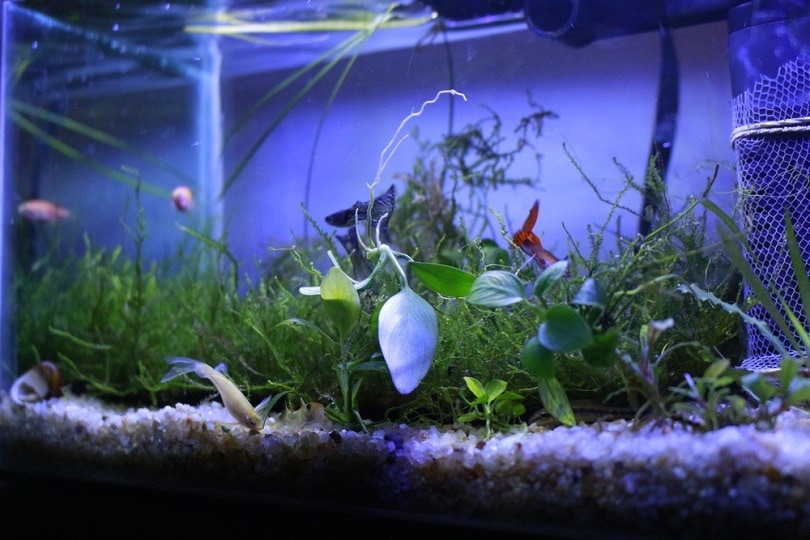
Benefits of Low Light Aquarium Plants
Why would you opt for low light aquarium plants? Here are some reasons:
To Make Your Fish More Comfortable
In the natural ecosystem, aquatic creatures prefer living next to plants. Vegetation not only provides them with a source of nutrition, but also a place to hide, spawn, or rest. Therefore, fish find a lot of comfort in such settings. Conversely, when the environment does not feel natural, aquatic animals are bound to start stressing.
Aesthetic Appeal
Aquariums without plants are more or less fixer-uppers for pet fish. And don’t forget that aquarium aesthetics matter. A tank with plush, vibrant plants can be an integral interior décor feature. Low light aquarium plants tend to be cost-friendlier, thus allowing you to add some personality to your tank without breaking the bank.
Purifying the Water
Normal plants require lots of light and CO2 for the process of photosynthesis. Low light plants, on the other hand, have to use other means since they have adapted to live in conditions where light and CO2 are deficient.
They survive through absorbing compounds such as ammonia – a byproduct of fish waste. In fact, even if you are content with standard aquarium plants, you should consider including an ammonia-absorbing low light plant. This is because high levels of ammonia are toxic to aquatic life.
Low light aquarium plants also help prevent algae bloom. This is because algae depend on compounds such as nitrates and phosphates for survival. Since these plants also go for the same compounds, you will not have to worry about algae in your tank. This means that you will not have to clean up often. And your fish will not be deprived of essential nutrients.
Taking care of Your Low Light Aquarium Plants
For standard aquarium plants, the most important factors to consider include lighting and water temperature. However, those conditions are not vital for low light aquarium plants, meaning that you do not have to invest in things such as bulbs and thermostats.
Unfortunately, the ability to survive under low light and low CO2 conditions comes at a cost; most low light aquarium plants have a slow growth rate.
To enhance that growth rate or help them thrive, pay attention to the following factors:
1. Substrate
Substrate allows you to provide your plants with a firm foundation for their roots. While most people go for soil-based substrates, gravel-based substrates are not bad options either. The most important factor to consider, however, is how nutrient-rich the substrate is.
Remember, low light plants do not have the convenience of using light and CO2 at will to make their food. Therefore, to thrive, they need to be in a nutrient-rich environment.
2. Filtration System
Despite being natural purifiers, low light aquarium plants need a three-stage filtration system to thrive. This is because they do not eliminate all the waste in the tank. When looking for a filter, opt for one whose flow reaches both ends of the tank, as such systems circulate water and nutrients more effectively.
Conclusion
Low light aquarium plants can do more than just beautify your tank; they can be incredibly helpful towards replicating a natural ecosystem inside the aquarium. What’s more, they are easy to set up and care for, making them ideal for beginners.
If you are just getting started, consider going with one or more from our reviews above, as they are some of the best low light aquatic plants out there.
Read More: 10 Best Cold Water Aquarium Plants
Featured Image Credit: Toxotes Hun-Gabor Horvath, Shutterstock









